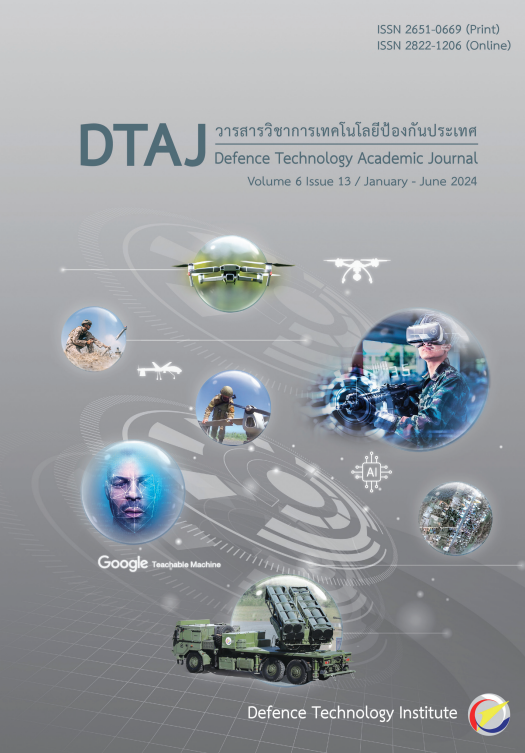Generative Artificial Intelligence and Its Military Application
Main Article Content
Abstract
This article is intended to 1) explore the development and application of Generative Artificial Intelligence (Generative AI) in military contexts; 2) analyze trends in the military application of Generative AI from 2024 to 2030; and 3) synthesize approaches for enhancing Thailand's military capabilities using Generative AI. The research indicates that the initial focus of Generative AI application in military operations primarily centered on supporting commanders' decision-making processes. However, as the capabilities of Generative AI have expanded, its application in military contexts is expected to broaden in tactical, operational, and strategic levels.
The trends in military applications of Generative AI between 2024 and 2030 can be categorized into three main groups: command and control, combat and warfare, and warfare support applications. When considering the linkage to levels of warfare, the majority of applications are expected to be at the tactical level, with operational level applications encompassing decision-making in command and control, warfare in the digital domain, psychological operations, and support for warfare. Strategic level applications are anticipated to involve decision-making processes and operations affecting the morale, spirit, and strength of the populace, which are critical components of warfare.
Generative AI is a disruptive technology that can enhance efficiency and provide a competitive advantage in military operations. This analysis thus recommends four main strategies for developing Thailand's military capabilities using Generative AI: 1) establishing infrastructure to support technology; 2) creating or improving large language models for military use; 3) defining operational guidelines; and 4) initiating applications in planned development projects by the Ministry of Defence and the Thai Armed Forces to further enhance operational performance and military capabilities in the future.
Downloads
Article Details

This work is licensed under a Creative Commons Attribution-NonCommercial-NoDerivatives 4.0 International License.
Journal of TCI is licensed under a Creative Commons Attribution-NonCommercial-NoDerivatives 4.0 International (CC BY-NC-ND 4.0) licence, unless otherwise stated. Please read our Policies page for more information...
References
K. Martineau. “What is generative AI?.” RESEARCH.IBM.com. https://research.ibm.com/blog/what-is-generative-AI (accessed Dec. 12, 2023).
NVIDIA, “Generative AI.” NVIDIA.com. https://www.nvidia.com/en-us/glossary/data-science/generative-ai (accessed Dec. 12, 2023).
H. Gimpel et al., Unlocking the Power of Generative AI Models and Systems such as GPT-4 and ChatGPT for Higher Education: A Guide for Students and Lecturers. Stuttgart, Germany: Univ. Hohenheim, 2023.
S. Lock. “What is AI Chatbot Phenomenon ChatGPT and Could It Replace Humans?.” THEGUARDIAN.com. https://www.theguardian.com/technology/2022/dec/05/what-is-ai-chatbot-phenomenon-chatgpt-and-could-it-replace-humans (accessed Dec. 20, 2023).
D. E. Wilkins and R. V. Desimone, Applying an AI Planner to Military Operations Planning. San Mateo, CA, USA: Morgan-Kaufmann Publishing, 1993.
K. L. Myers. “Advisable Planning Systems.” CDN.AAAI.org. https://cdn.aaai.org/ARPI/1996/ARPI96-028.pdf (accessed Dec. 13, 2023).
Scribble Data. “Large Language Models 101: History, Evolution and Future.”
SCRIBBLEDATA.io. https://www.scribbledata.io/large-language-models-history-evolutions-and-future (accessed Dec. 15, 2023).
K. Manson. “The US Military Is Taking Generative AI Out for a Spin.” BLOOMBERG. com. https://www.bloomberg.com/news/newsletters/2023-07-05/the-us-military-is-taking-generative-ai-out-for-a-spin (accessed Dec. 15, 2023).
U.S. Department of Defense. “DOD Announces Establishment of Generative AI Task Force.” DEFENSE.gov. https://www.defense.gov/News/Releases/Release/rticle/3489803/dod-announces-establishment-of-generative-ai-task-force (accessed Dec. 21, 2023).
H. - M. Chuang and D. - W. Cheng, “Conversational AI over Military Scenarios Using Intent Detection and Response Generation.” Appl. Sci., vol. 12, no. 5, p. 2494, 2022, doi: 10.3390/app12052494.
W. Marcellino, N. Beauchamp-Mustafaga, A. Kerrigan, L. N.
Chao, and J. Smith, The Rise of Generative AI and the Coming Era of Social Media Manipulation 3.0: and Coping with Ubiquitous AI. Santa Monica, CA, USA: RAND Corporation, 2023.
J. Harper. “Pentagon Requesting More Than$3B for AI, JADC2.” DEFENSESCOOP.com. https://defensescoop.com/2023/03/13/pentagon-requesting-more-than-3b-for-ai -jadc2 (accessed Dec. 21, 2023).
B. Vincent. “Inside Task Force Lima’s Exploration of 180-plus Generative AI Use Cases for DOD.” DEFENSESCOOP.com. https://defensescoop.com/2023/11/06/inside-task-force-limas-exploration-of-180-plus-generative-ai-use-cases-for-dod (accessed Jan. 4, 2024).
C. Malin. “Why the Military Needs Generative AI.” ARMADAINTERNATIONAL.com. https://www.armadainternational.com/2023/10/why-the-military-needs-generative-ai (accessed Jan. 4, 2024).
J. Baughman. “China’s ChatGPT War.” AIRUNIVERSITY.AF.edu. https://www.airuniversity.af.edu/Portals/10/CASI/documents/Research/Cyber/2023-08-21 China's ChatGPT War.pdf (accessed Jan. 4, 2024).
G. C. Allen. “China’s Pursuit of Defense Technologies: Implications for U.S. and Multilateral Export Control and Investment Screening Regimes.” CSIS.org. https://www.csis.org/analysis/chinas-pursuit-defense-technologies-implications-us-and-multilateral-export-control-and (accessed Dec. 23, 2023).
สำนักนโยบายและแผนกลาโหม, “แผนปฏิบัติ ราชการ ระยะ 5 ปี (พ.ศ. 2566 – 2570) กระทรวงกลาโหม,” สำนักงานปลัดกระทรวงกลาโหม, กระทรวงกลาโหม, กรุงเทพฯ, ไทย, 2565.
กรมยุทธการทหาร, “แผนปฏิบัติราชการ ระยะ 5 ปี (พ.ศ. 2566 – 2570) กองบัญชาการกองทัพไทย,” กองบัญชาการกองทัพไทย, กระทรวงกลาโหม, กรุงเทพฯ, ไทย, 2565.
น. หัสถีธรรม. “ความท้าทาย ความเป็นไปได้ และโอกาสของ Open Thai GPT แชตบอทสัญชาติไทย.” THESTORYTHAILAND.com. https://www. thestorythailand.com/13/05/2023/99502 (accessed Dec. 21, 2023).


